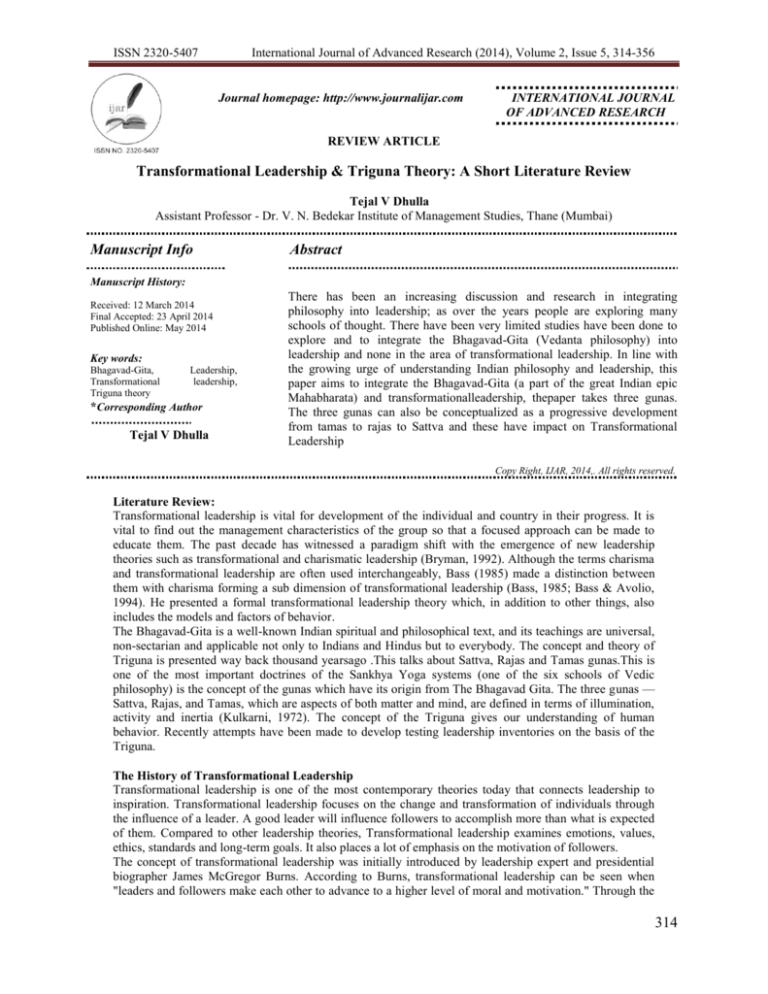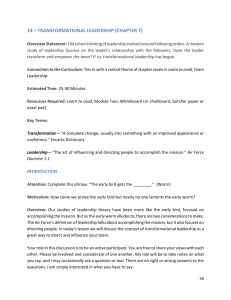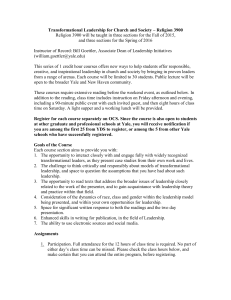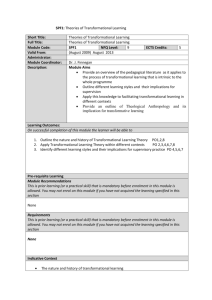
ISSN 2320-5407
International Journal of Advanced Research (2014), Volume 2, Issue 5, 314-356
Journal homepage: http://www.journalijar.com
INTERNATIONAL JOURNAL
OF ADVANCED RESEARCH
REVIEW ARTICLE
Transformational Leadership & Triguna Theory: A Short Literature Review
Tejal V Dhulla
Assistant Professor - Dr. V. N. Bedekar Institute of Management Studies, Thane (Mumbai)
Manuscript Info
Abstract
Manuscript History:
Received: 12 March 2014
Final Accepted: 23 April 2014
Published Online: May 2014
Key words:
Bhagavad-Gita,
Transformational
Triguna theory
Leadership,
leadership,
*Corresponding Author
Tejal V Dhulla
There has been an increasing discussion and research in integrating
philosophy into leadership; as over the years people are exploring many
schools of thought. There have been very limited studies have been done to
explore and to integrate the Bhagavad-Gita (Vedanta philosophy) into
leadership and none in the area of transformational leadership. In line with
the growing urge of understanding Indian philosophy and leadership, this
paper aims to integrate the Bhagavad-Gita (a part of the great Indian epic
Mahabharata) and transformationalleadership, thepaper takes three gunas.
The three gunas can also be conceptualized as a progressive development
from tamas to rajas to Sattva and these have impact on Transformational
Leadership
Copy Right, IJAR, 2014,. All rights reserved.
Literature Review:
Transformational leadership is vital for development of the individual and country in their progress. It is
vital to find out the management characteristics of the group so that a focused approach can be made to
educate them. The past decade has witnessed a paradigm shift with the emergence of new leadership
theories such as transformational and charismatic leadership (Bryman, 1992). Although the terms charisma
and transformational leadership are often used interchangeably, Bass (1985) made a distinction between
them with charisma forming a sub dimension of transformational leadership (Bass, 1985; Bass & Avolio,
1994). He presented a formal transformational leadership theory which, in addition to other things, also
includes the models and factors of behavior.
The Bhagavad-Gita is a well-known Indian spiritual and philosophical text, and its teachings are universal,
non-sectarian and applicable not only to Indians and Hindus but to everybody. The concept and theory of
Triguna is presented way back thousand yearsago .This talks about Sattva, Rajas and Tamas gunas.This is
one of the most important doctrines of the Sankhya Yoga systems (one of the six schools of Vedic
philosophy) is the concept of the gunas which have its origin from The Bhagavad Gita. The three gunas —
Sattva, Rajas, and Tamas, which are aspects of both matter and mind, are defined in terms of illumination,
activity and inertia (Kulkarni, 1972). The concept of the Triguna gives our understanding of human
behavior. Recently attempts have been made to develop testing leadership inventories on the basis of the
Triguna.
The History of Transformational Leadership
Transformational leadership is one of the most contemporary theories today that connects leadership to
inspiration. Transformational leadership focuses on the change and transformation of individuals through
the influence of a leader. A good leader will influence followers to accomplish more than what is expected
of them. Compared to other leadership theories, Transformational leadership examines emotions, values,
ethics, standards and long-term goals. It also places a lot of emphasis on the motivation of followers.
The concept of transformational leadership was initially introduced by leadership expert and presidential
biographer James McGregor Burns. According to Burns, transformational leadership can be seen when
"leaders and followers make each other to advance to a higher level of moral and motivation." Through the
314
ISSN 2320-5407
International Journal of Advanced Research (2014), Volume 2, Issue 5, 314-356
strength of their vision and personality, transformational leaders are able to inspire followers to change
expectations, perceptions, and motivations to work towards common goals.
Later, researcher Bernard M. Bass expanded upon Burns' original ideas to develop what is today referred to
as Bass‘ Transformational Leadership Theory. According to Bass, transformational leadership can be
defined based on the impact that it has on followers. Transformational leaders, Bass suggested, garner trust,
respect, and admiration from their followers.
Model of Transformational Leadership
Burns developed the 4 I’s which are Idealized Influence, Inspiration Motivation, Intellectual Stimulation,
and Individual consideration. The 4 I‘s all relate to one common theme, which is to become a better person
as a leader and inspire your followers to do the same.
The Components of Transformational Leadership
Bass suggested that there were four different components of transformational leadership which are as
follows.
Intellectual Stimulation – Transformational leaders not only challenge the status quo; they also encourage
creativity among followers. The leader encourages followers to explore new ways of doing things and new
opportunities to learn.
Individualized Consideration – Transformational leadership also involves offering support and
encouragement to individual followers. In order to foster supportive relationships, transformational leaders
keep lines of communication open so that followers feel free to share ideas and so that leaders can offer
direct recognition of the unique contributions of each follower.
Inspirational Motivation – Transformational leaders have a clear vision that they are able to articulate to
followers. These leaders are also able to help followers experience the same passion and motivation to
fulfill these goals.
Idealized Influence – The transformational leader serve as a role model for followers. Because followers
trust and respect the leader, they emulate this individual and internalize his or her ideals.
The History of Triguna Theory:
The concept of Triguna mentioned in Atharveda. However, it is in the Samkhya system, that this concept
has gained prominence as a major explanatory construct. Samkhya is a dualistic philosophy, which
postulates two interdependent, simultaneously existing realities purusha (Consciousness) and prakrti
(nature or matter).Apart from the purusha, which forms the inner core of the personality, everything in the
universe, physical and psychological, including the mind, are regarded as originated from prakrti, which is
constituted of three gunas viz. sattva, rajas and tamas. These gunas act together and never exist in isolation.
They interact and compete with each other resulting in the preponderance of one over the others. The
degree of predominance of one guna determines the individual‘s personality type. Based on the above
understanding, personalities are categorized into three viz. sattvic, rajasic and tamasic types (Rao, 1966).
Prakriti is composed of three Gunas: Sattva (white, knowledge, and happiness), Rajas (red, activity and
pain) and Tamas (dark, resistance or inertia andconfusion). Thus, it is endowed with all the necessary and
sufficient powers of production, preservation and dissolution of the phenomenal world.
The three Gunas—Sattva, Rajas and Tamas—also promote different kinds of temperament based on the
dominance of one or the other Gunas. The temperament of a person can be discerned based on the ―mode
of worship, the type of food consumed and other activities of everyday life‖ (Krishnan, 2002).
Model of Triguna Theory:
As each Guna contributes certain characteristic qualities to the person, based on which an individual can be
classified as belonging to that particular Guna type. Charaka and Sushruta recognize seven types or
315
ISSN 2320-5407
International Journal of Advanced Research (2014), Volume 2, Issue 5, 314-356
categories into which people can be classified, depending on the dominance of the Gunas in their body.
They are said to belong to a particular Guna combination, as follows:
1. People with dominant Sattva Guna.
2. People with dominant Rajas Guna.
3. People with dominant Tamas Guna.
4. People with dominant Sattva–Rajas Guna combination.
5. People with dominant Sattva–Tamas Guna combination.
6. People with dominant Rajas–Tamas Guna combination.
7. People with balanced Gunas or with Sattva–Rajas–Tamas Guna combination
Where do the two Theories Meet?
Based on the research study conducted by Kejriwal and Krishnan (2004)where they tried to relate Gunas
and Vedic worldview to transformational leadership. The results showed that Sattva, Sattva - Rajas and
Vedic worldview enhance transformational leadership whereas Tamas reduces transformational leadership.
Likewise Narayanan and Krishnan (2003) studied relationship between Gunas, Karma - Yoga and
transformational leadership. Results demonstrated that three Sattva dimensions (sympathy, motivation to
work and accepting pain) enhance transformational leadership and two Rajas dimensions (attribution, and
right and wrong) reduce Karma Yoga. Karma Yoga is not related totransformational leadership. The most
significant finding of the study was that transformational leadership was positively related to Sattva and not
Rajas guna. Karma Yoga was related to Rajas guna negatively and was not related to Sattva guna.
Both Triguna theory and Transformational Leadership focus on adopting positive approach of life. Triguna
theory offers the process of transformation, to move from Tamas to Rajas and from Rajas to Sattva and
even tell us about going beyond gunas — ‗Gunatita‘.The emphasis in both the individual improvement and
development and emphasis more on self-management.
Conclusion:
Sankhya theory suggests techniques which focus on inward development of Self-management. Techniques
suggested for the promotion of Sattva can be applied for the development of Transformation Leadership.
Where Bhagavad-Gita recommends a transformational leadership approach, which focuses on exploring the
inner world of the self (inside-out), unlike the western approach to transformational leadership, which
focuses in exploring the external world of matter and energy (out-side in).
Theory of Triguna provides a very useful framework to understand Leadership. The type of guna dominant
in the leader at a particular point of time is responsible for the way he responds to the challenges he faces at
work. Today's world is more characterized by Rajasik tendencies and the result is love of fame, pride,
display of power etc. Such tendencies affect work because it results in an environment where everyone is in
a hurry to achieve individualistic goals. There is expectation for rewards for anything done. When Tamasik
tendencies take over, the result is darkness of the mind. He is callous about his duties. He yearns neither to
learn nor to work. With Sattva tendencies as dominant, Leader feels it is his duty to perform under any
circumstances. He has a calm and serene mind, is alert and performs his job with precision.
Therefore, noting the similarities between the two concepts, these two theories need not be
compartmentalized as Indian and Western approaches to individual development. There is a wide scope of
merging the two
References:
1. Bass. M. (1985). Leadership and Performance. N. Y,: Free Press.
2. Bass, B. M., & Avolio, B. J. (Eds.), (1994). Improving organizational effectiveness through
transformational leadership. Thousand Oaks, CA: Sage.
3. Bass, B. M. & Riggio, R. E. (2008). Transformational Leadership. Mahwah, New Jersey:
Lawrence Erlbaum Associates, Inc.
4. Bass & Bass 2008, The Bass Handbook of Leadership: Theory, Research, and Managerial
Applications" 4th edition Free Press
5. Bryman, A. (1992). Charisma and leadership in organizations. London: Sage
6. Burns, J. M. (1978). Leadership. N.Y: Harper and Raw.
7. Kejriwal, A. and Krishnan, V. R. (2004). Impact of Vedic Worldview and Gunas on
Transformational Leadership, Vikalpa: The Journal for Decision Makers, 29(1), 29-40.
8. Krishnan B. Typological conceptions in ancient Indian thought. In: Misra G, Mohanty AK,
editors. Perspectives on indigenous psychology. New Delhi: Concept Publishing Company; 2002.
pp. 292–304.
316
ISSN 2320-5407
International Journal of Advanced Research (2014), Volume 2, Issue 5, 314-356
9.
Kulkarni (1972). In Rao, P.V. Krishna and Harigopal, K. (1979). The Triguna and ESP: An
Exploratory Investigation, Journal of Indian Psychology, 2(1), 63-67.
10. Narayanan, Jayanth and Krishnan, Venkat R. (2003), Impact of Sattva and Rajas Gunas on
Transformational Leadership and Karma Yoga, Journal of Indian Psychology, Vol. 21, No.2, 1-11.
11. Subhash S (1998). ―Enlightened leadership in Indian Ethos: The way of the Theory K‖
Management & Change, Vol. 2, No. 1, January-June 1998, pp.93-104
Rao, K. B. R. (1966). Theism in pre-classical Samkhya. Mysore: Prasaranga, University of
Mysore.
12. Riggio, R.E. (2009, March 24). Are you a transformational leader. Psychology Today. Found
online
at
http://blogs.psychologytoday.com/blog/cutting-edge-leadership/200903/are-youtransformational-leader
317










